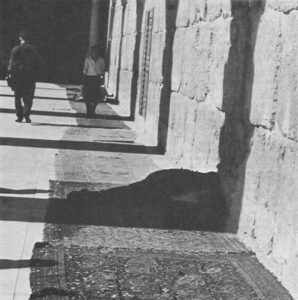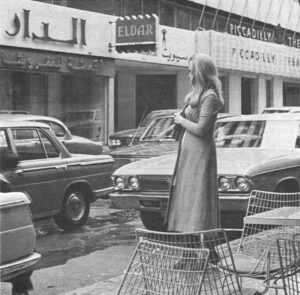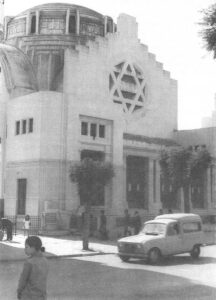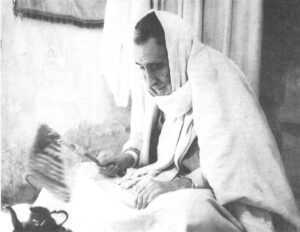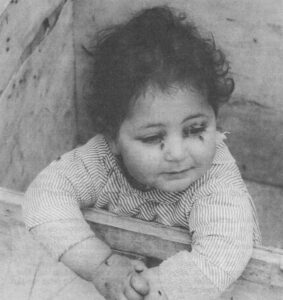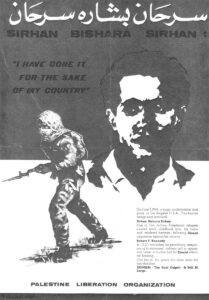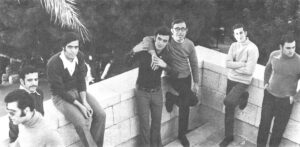Rogers makes headlines. Sadat makes ultimatums. Golda makes recriminations. And Dayan’s military government in Israel’s occupied territories makes facts. All of these activities, world opinion hopes, are some weird windup to a peaceful follow-through.
Ever since June 1967, when Dayan’s army occupied the West Bank of Jordan and the Gaza Strip, home of about half the world’s Palestinians, Israel’s main objective has been security. Nevertheless, the military government has also undertaken civilian responsibilities for their legendary enemies, the Palestinians, with almost as much enthusiasm as when it stormed the area in June 1967. According to the guidelines of the “economic and administrative policies of the Coordinator of Government Operations in the Administered Territories,” Dayan’s Ministry of Defense assumed
“…The responsibility of the State of Israel to provide a decent life for the people in the territories. The very fact that the Military administration is the one and only ruler of the area makes it responsible for the welfare of the population.”
Assuming responsibility for the welfare of the population stretched the military’s authority to encompass social and economic tasks in addition to securing the area militarily. It also stretched the scope of the Military Command’s control. Indeed, security is an important consideration in what would seem otherwise to be civilian affairs. For example, according to the guidelines:
“For as long as this situation [no formal peace settlement] will last, and today no other solution is seen in the near future-it will be ever more difficult to maintain a standard of living in the territories that is drastically different from that in Israel. The only way to avoid a potential outburst of social forces, is to strive continuously for the improvement of the standard of living and services of this underprivileged society.”
In addition, humanitarian motives aside, the army’s involvement in West Bank economic affairs is a way to spur self-sufficiency of the area. The more the Israeli-occupied territories pay their own way, the less the conqueror has to pay out of its own pocket to support the conquered.
The effect of this active economic policy is economic interlocking – Dayan prefers this term to “integration” of the administered territories and Israel. The guidelines explain:
“As a matter of fact, the Six Day War erased the ‘Green Line’ (the 1949 Armistice Line between Israel and Jordan) that used to separate Israel from the areas now administered and it is quite unavoidable and natural that these areas now depend on Israel in all economic matters and services.”
Having the population economically depend on Israel no doubt buys – at least temporarily – Arab cooperation with Israeli authorities. Furthermore, a possible future by-product of the development of mutual Arab-Israeli economic interests is the formation of groundwork for a lasting Arab-Israeli peace settlement.
Officials talk of a future economic confederation like Benelux which would include Israel, the West Bank, Gaza, and the East Bank of Jordan plus outlets through the confederation to markets of other Arab states. It is not surprising that Israeli thought, which is ingrained with socialist ideology, would favor economic deterministic schemes to peace. Dayan, however, has not been entirely free to execute the vision of economic cooperation as a functional approach to peace.
In 1968 Minister of Finance Pinhas Sapir led objectors to Dayan’s activist policy in the occupied territories. The dissenters doubted the benefits of such intimate interchange between Israel and the Arabs advocated by Dayan. It might lead, according to Dayan’s opponents, to an eventual watering down of the Jewish character of the State of Israel.
Since both Prime Minister Levi Eshkol and his successor in March, 1969, Golda Meir, thought public debate of the future outlines of the occupied territories would be harmful, official policy was never publicly agreed upon. The decision not to decide – at least publicly – was based on Israel’s wait-and-see position which was vague enough as to be interpreted as acceptance of the United Nations November, 1967, resolution obliging Israel to withdraw from occupied territories and Arab countries to recognize and come to peaceful terms with Israel.
In its fifth year of waiting-and-seeing, the government still has not publicly sanctioned an official policy. And in the years since the Sapir-Dayan near-debate, there seems to have been even less public discussion of the subject. Diplomatic attention has focused first on coming to terms with Egypt; once Egypt is taken care of, Israel can afford to concentrate on outlining Israel’s position on the occupied territories. (The major exception is Arab Jerusalem, which Israel has already “unified” or annexed to Israel.)
Dayan is not, however, a waiting-and-seeing type. Having no public debate has not prevented – and may have even assisted him to realize his ideas of Israel-Arab economic cooperation.
The first major economic decision of the military government after the war simply aimed to revive the prostrate post-1967 War West Bank economy. To stimulate the economy, the Israeli administration partially substituted for important economic activities of the previous Jordanian civilian administration and – more important – for jobs which had existed servicing the Jordanian army in the West Bank. The Israelis absorbed some public service workers into their own administration and also carried out WPA-like projects. As a result, improved roads and facilities also help Israel maintain the security of the area. Security always seems to be the major objective of any decision of the Military Command in the occupied territories. For example, “normalization” is an important technique of the occupation because as Dayan has reportedly said, “When life is normal, people would resist anyone trying to disturb it.” To get things running “normally” – i.e., as if there is no occupation – Israel uses local administrators who had served the Jordanians and who are familiar with their own area’s problems. Using local citizens also frees Israelis who are in great demand in Israel’s shorthanded post-War economy.
Another early decision consistent with the “normalization” policy sustained the traditional economic-as well as familial and cultural – links between the West Bank of Jordan occupied in 1967 and the rest of the Arab world. The policy called “open bridges” started by reestablishing traditional markets for West Bank vegetables in Transjordan and other Arab states; it revived the trade that had been broken off during the June War. Open bridges are still Israel’s policy; there is constant traffic of goods and people between the Israeli occupied territories and Jordan.
People are given exit permits to visit beyond the cease-fire lines and if necessary the permit will be for a long-term leave for study or work purposes. This summer the policy of open bridges was extended so that not only could West Bankers visit the East but one hundred and seven thousand visitors, relatives of inhabitants of the West Bank constituting one-tenth of all Palestinians living outside Israel or occupied Jordan, were permitted to visit Israel this summer from June 15 to September 15. The scheme was also a net economic benefit to Israel and the West Bank as these visitors spent a great deal of money bolstering the lagging West Bank tourist industry.
Israel is using as a link to her Arab neighbors the traffic among the one million Palestinians under occupation and the sixty to seventy percent of the population of Jordan remaining under King Hussein today who are Palestinians. (The other Palestinians out of an Israeli-estimated total of two and one-half million are either Israeli Arabs – one-half million – or residents of other Arab states or abroad.) The Military Government’s guidelines explain Israeli thinking on open bridges:
…Relatively little risk is involved through a renewed contact between the Arabs of the areas and those of the surrounding Arab countries, and of course the over-all gains exceed the losses. After all, for twenty years Israel has been willing to keep open land borders with the Arab countries; it follows, therefore, that the Israelis won’t be the ones to close them.”
In spite of open bridges, Israel is reorienting West Bank agriculture, which with related services accounts for more than half the West Bank’s national income, away from the East Bank and the rest of the Arab world and toward markets in Israel and Western Europe. Along that line, Israel’s ban on administered territories’ produce, which is cheaper than that of Israel, has eased since the early days of occupation. Israel aims to make West Bank crops less dependent on the vagaries of Arab policies and thus to avoid what occurred this summer when there was an abortive attempt to arrange an Arab League boycott of West Bank goods which allegedly -included clandestine Israeli goods.
Reorienting markets called for a new crop program, which was initially successful. Preservable crops such as beans, sesame, and cotton replaced watermelons and other highly perishable goods.
Eventually, however, a new factor changed the character of West Bank agriculture even more dramatically. Unemployment in the West Bank had declined thanks to the successful agriculture program, which stressed labor intensive as well as less perishable crops. But Israel’s economy, which was in a post-War boom, began drawing on Arab manpower for construction and farm work within Israel. So Arab landowners found themselves competing with high Israeli wages to keep the farmhands they needed. Since wages constitute half the production costs of unirrigated crops and ninety-five percent of the West Bank is unirrigated, farm costs rose by twenty-five percent while income from produce sold to the Arab markets across the Jordan River remained steady.
Because of rising costs, the marginal farmer was forced – as well as attracted by Israeli wages – to leave farm work to the women and children and get a job in Israel.
This was the first step toward creating an Arab labor force dependent on Israel. These ex-farmers-together with refugees (supposedly unemployed and on United Nations Relief and Works Agency welfare) and a few white-collar workers attracted by Israeli wages – working in Israel amount to thirty to thirty-five thousand West Bank wage earners, or one-quarter of the entire West Bank labor force. West Bank and Gaza Strip labor combined working daily in Israel amount to about forty-five thousand men.
The larger farmer was also finding it hard to make a profit because of the rising cost of goods and labor. But rather than have farmers return to traditional less labor intensive crops and return to greater dependency on Arab markets, the Israeli administration introduced modern agriculture techniques and crops with higher yields so that more sales would compensate for rising prices. Lowering the Israeli barrier against crops from the administered territories in Israel also helped although vegetables for export is still quite a small amount.
These adjustments in agricultural production are indicators of coordination between Israel and the administered areas. Industrial growth is also related to the closer economic ties with Israel. Actually industry on the West Bank was bound to expand after 1967 since according to Israeli authorities during the nineteen previous years of Jordanian rule, the Jordanian regime had allegedly discouraged new industries in the West Bank to favor East Bank development. Since the 1967 occupation, Israeli government loans and credit have stimulated expansion of established plants and the establishment of new ones.
Industry is adjusting to Israeli demand taking sub-contracting jobs for Israeli plants in clothing, food, building material, and plastics and by developing labor intensive branches where they have a comparative advantage such as furniture and sewing. Productivity continues to rise. And the number of laborers employed in industry since 1967 has grown by several thousand to reach seven thousand. (The government does not provide as much information on the industrial sector as it does, for example, on agriculture because, one high Foreign Ministry official explained such information invites sabotage.)
Other sectors of the economy – commerce and construction – also profit from the administered territories integration into the Israeli economy. As more people are employed with more money to spend, commerce is rosy and construction is up fifteen percent this year. People first buy better food, then more clothes, televisions, furniture, and after that, construction of an additional room to the house. There are twenty seven thousand televisions on the West Bank today compared to three thousand immediately after the war. And since many villages still have no electricity, a television purchase also requires purchase of a generator. The marriage market is better too; one Israeli expert on Palestinian social conditions reported that some Arab workers could now afford to buy a second wife – even though the price has reportedly doubled for “an educated girl” from two hundred and twenty Israeli pounds to four hundred and fifty pounds (a jump of fifty dollars to one hundred and seven dollars).
The only group whose wages have remained stable are the public servants. (There are eight thousand, five hundred in the West Bank alone.) Israeli authorities have raised their salaries four times since 1967 to match the rising cost of living. The public servants also have been receiving a double salary from their sovereign, King Hussein, in an apparent attempt by the King to sustain loyalty from his subjects now under Israeli occupation.
Each class and sector of the administered territories’ economy seems to have grown dependent on Israel for prosperity. A pattern of integration of the economy of the occupied territories into Israel has become manifest. Dayan had talked of the economies interlocking. What has happened, however, is that the less developed West Bank has become dependent on the stronger, more industrialized and developed economy of Israel.
Further, according to the Bank of Israel’s report on “The Economy of the Administered Areas 1970”: “While economic ties with Israel have become stronger, the ties of Judea and Samaria [Israeli names for the West Bank] with Jordan have weakened, as evidenced by the steep decline in trade over the Jordan bridges.” In 1970 about one-half of West Bank exports went to Israel and one-half to Jordan. But imports in that year were overwhelmingly from Israel. Imports from Israel were valued at 183,000,000 Israeli pounds out of a total of 215,000,000 pounds worth of goods imported. The Bank of Israel report continued, “there was substitution of Israeli imports for the imports from Jordan and overseas, and exports of labor services to Israel almost doubled. Both elements brought about closer economic ties between the Israeli economy and that of the areas…In effect, a common market of three regions is in the process of being established with a uniform customs barrier between them and the rest of the world.”
The Common Market image or the Benelux model are often mentioned by officials as goals towards which Israel is working in its economic activity in the occupied territories. These men like to think that they are laying groundwork for long-lasting, Arab-Israeli cooperation based on economic self-interest.
Money changes a person’s pocketbook, not a man’s heart. The Israelis realize this and know they are not loved. Dayan who made a tour of American activities including the pacification program in Vietnam is not trying to buy political support as some have accused America of doing. Dayan’s policy seems to aim simply at gaining economic cooperation. And even if this vision of a final peaceful Middle Eastern Benelux is never realized, the military command can claim success in its primary objective: security. For in the short term at least – until newly rising expectations outstrip economic delivery – the Palestinians of the occupied territories have hardly bitten the hand that helps feed them.
Received in New York on February 2, 1972.
©1971 Paula Stern
Paula Stern, a free-lance writer, is an Alicia Patterson Fund award winner. This article may be published with credit to Ms. Stern and the Alicia Patterson Fund.

